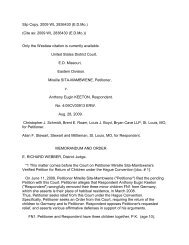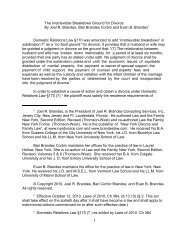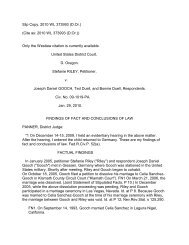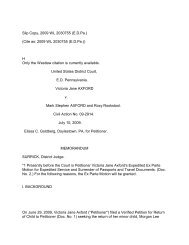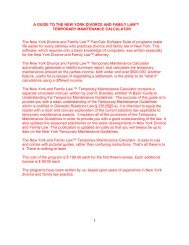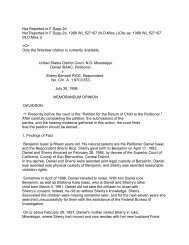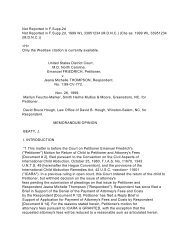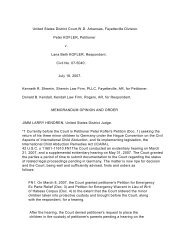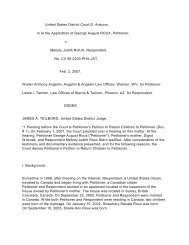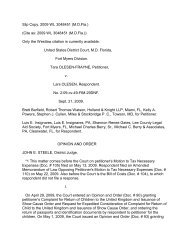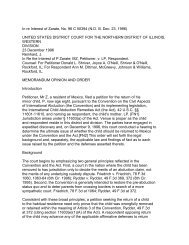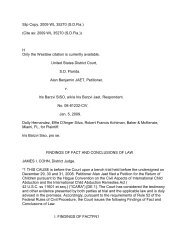Etienne v. Zuniga
Etienne v. Zuniga
Etienne v. Zuniga
You also want an ePaper? Increase the reach of your titles
YUMPU automatically turns print PDFs into web optimized ePapers that Google loves.
(1) When did the removal or retention at issue take place? (2) Immediately prior to the<br />
removal or retention, in which state was the child habitually resident?<br />
(3) Did the removal or retention breach the rights of custody attributed to the petitioner<br />
under the law of the habitual residence? (4) Was the petitioner exercising those rights<br />
at the time of the removal or retention?<br />
239 F.3d at 1070.<br />
Here, in answer to the first question, the Court has found that retention of the children<br />
took place in January of 2009. See infra Section I.D.3. Next, the Court must decide in<br />
which state, immediately prior to the retention of the children, E.N. and B.N. were<br />
habitually resident. Mozes, 239 F.3d at 1070.<br />
<strong>Etienne</strong>, in his closing argument brief, asserts that the parties are in agreement that the<br />
children's habitual place of residence prior to their removal was Mexico.<br />
Dkt. 60 at 5 & fn.2. <strong>Etienne</strong> is correct that Villarreal does not dispute that E.N.<br />
and B.N. were habitually resident in Mexico prior to July of 2008. However, the relevant<br />
question in this case is where the children were habitually resident prior to their<br />
retention in early 2009. Id. at 1070. <strong>Etienne</strong> argues, for purposes of whether his<br />
petition was filed within one year of the wrongful removal or retention, that the children<br />
were wrongfuly retained in February of 2009. Thus, <strong>Etienne</strong> may not then argue that,<br />
for purposes of habitual residence, the Court look to the "removal" of the children in<br />
July of 2008 as it is undisputed that such removal occurred with <strong>Etienne</strong>'s permission<br />
and therefore was not "wrongful"<br />
under the Convention.<br />
Accordingly, the Court will consider whether E.N. and B.N. were habitually resident in<br />
the United States prior to their retention. In Mozes, the Ninth Circuit addressed at<br />
length the issue of how a court should determine the habitual residence of children<br />
under the Convention. 239 F.3d at 1071-84. First, the Court must look at the settled<br />
intention of the person to abandon the habitual residence left behind. Id. at 1075. This<br />
intention need not be present "at the moment of departure; it could coalesce during the<br />
course of a stay abroad originally intended to be temporary. Nor need the intention be<br />
expressly declared, if it is manifest from one's actions." Id. Whether or not there is a<br />
settled intention to abandon a prior habitual residence is a question of fact. Id.<br />
*5 The question arises, then, "[w]hose settled intention determines whether a child<br />
has abandoned a prior habitual residence?" Id. at 1076 (emphasis in original). While a<br />
court may be inclined to conclude that it is, of course, the child's intention that applies,<br />
there is an obvious problem with such a conclusion. Id. "Children, particularly the ones<br />
whose return may be ordered under the Convention [those under the age of 16],<br />
normally lack the material and psychological wherewithal to decide where they will<br />
reside." Id. (footnote omitted). Therefore, in cases where it is necessary to decide<br />
whether the stay in a foreign state was intended to be temporary and short-term, the<br />
intention that applies is that of the "person or persons entitled to fix the place of the<br />
child's residence." Id. (internal quotation marks omitted). However, difficulty arises<br />
"when the persons entitled to fix the child's residence no longer agree on where it has



